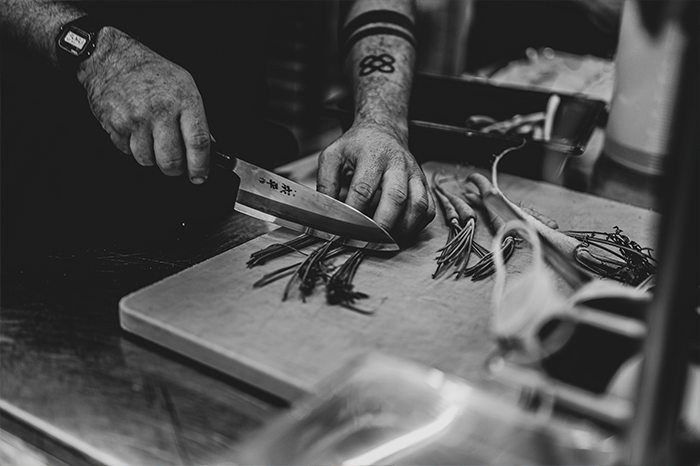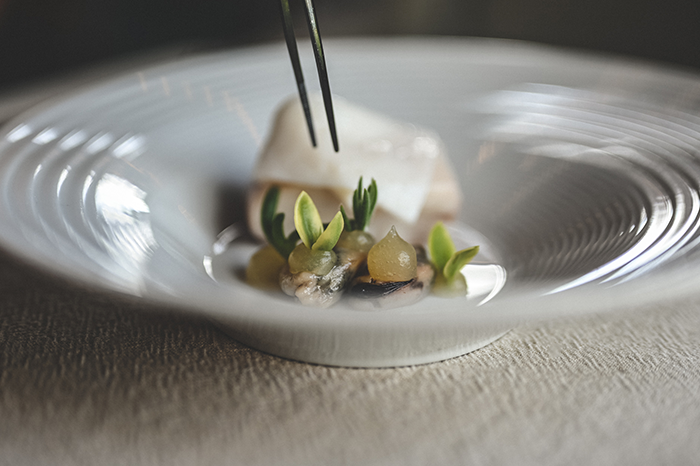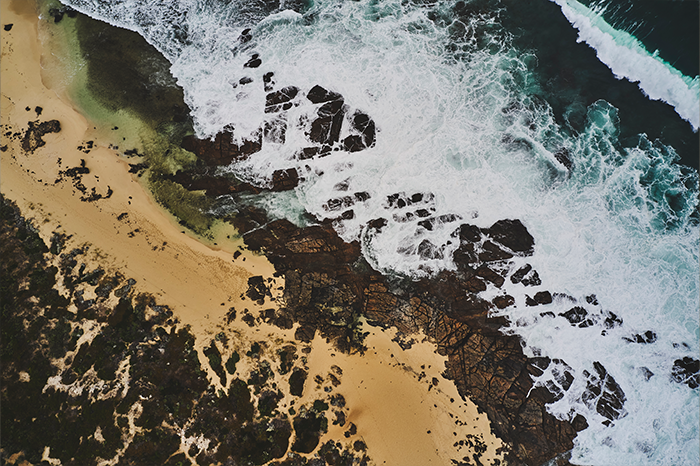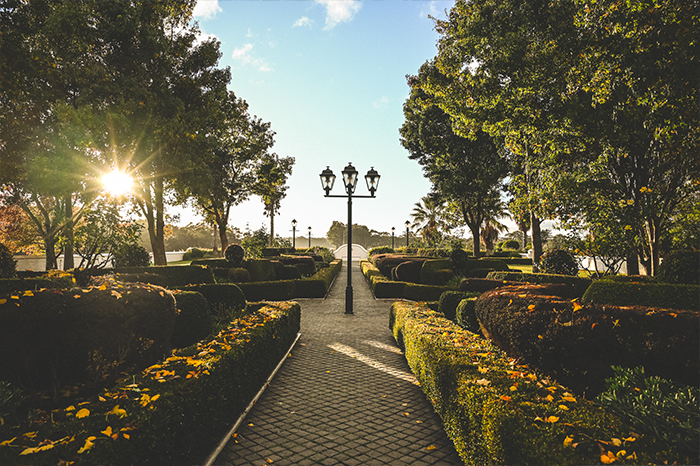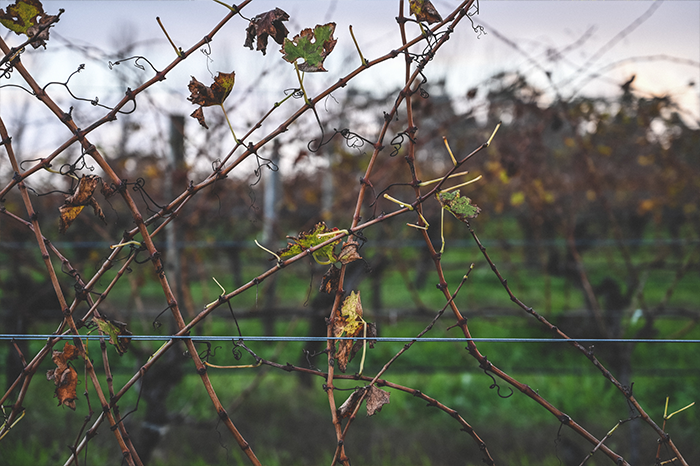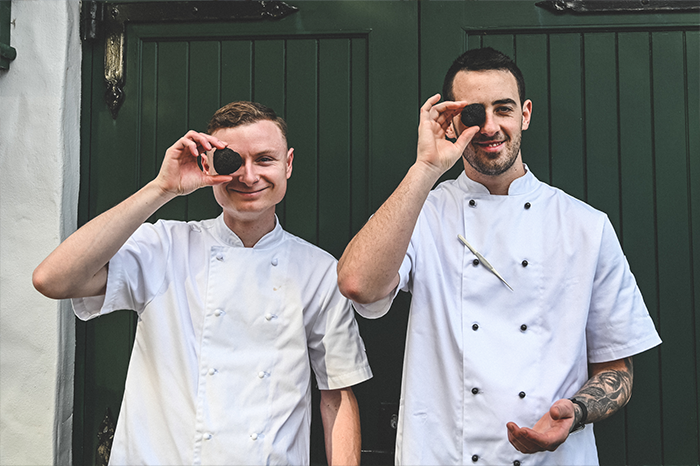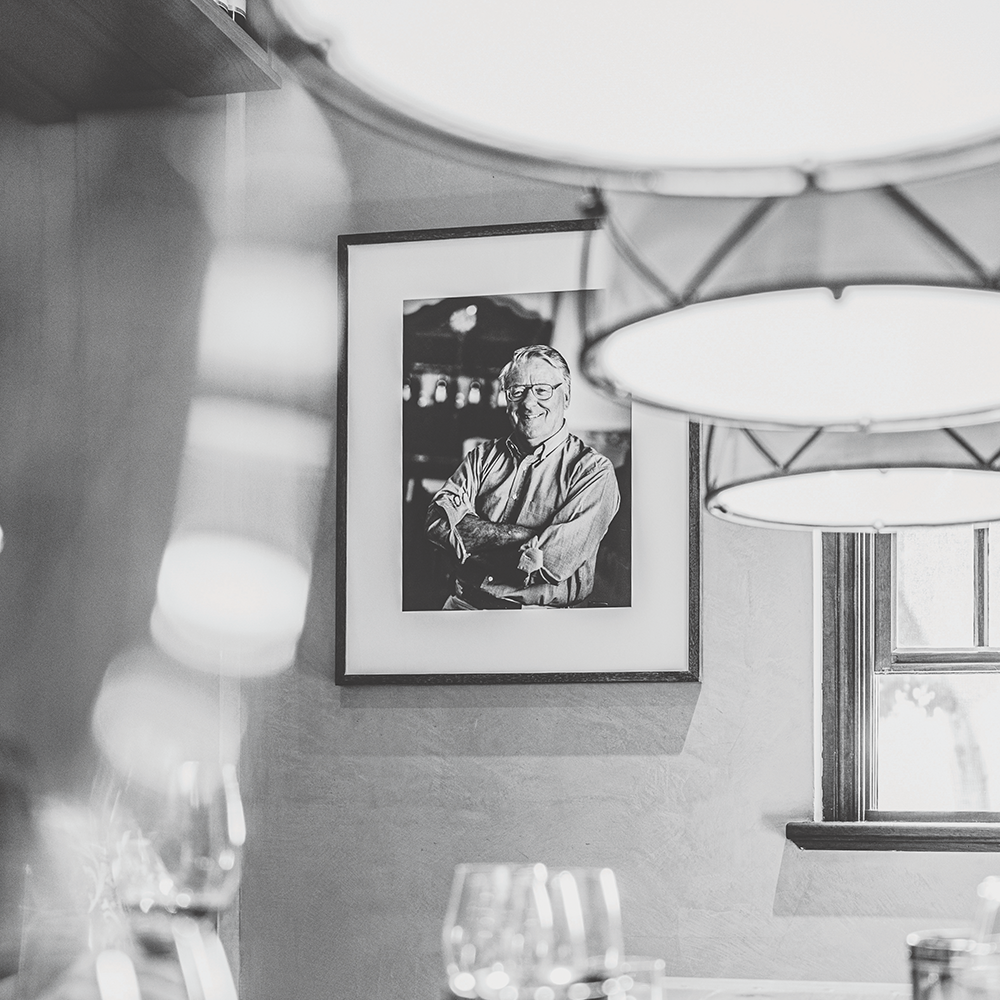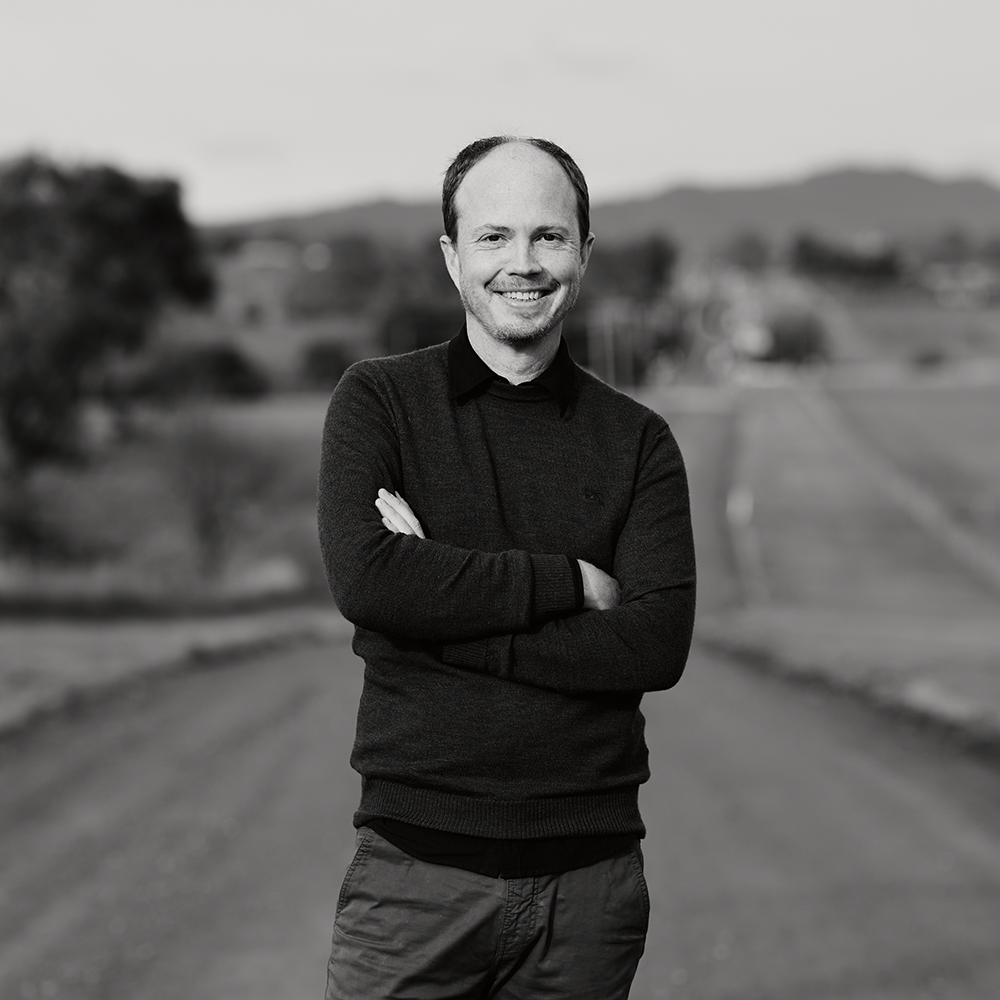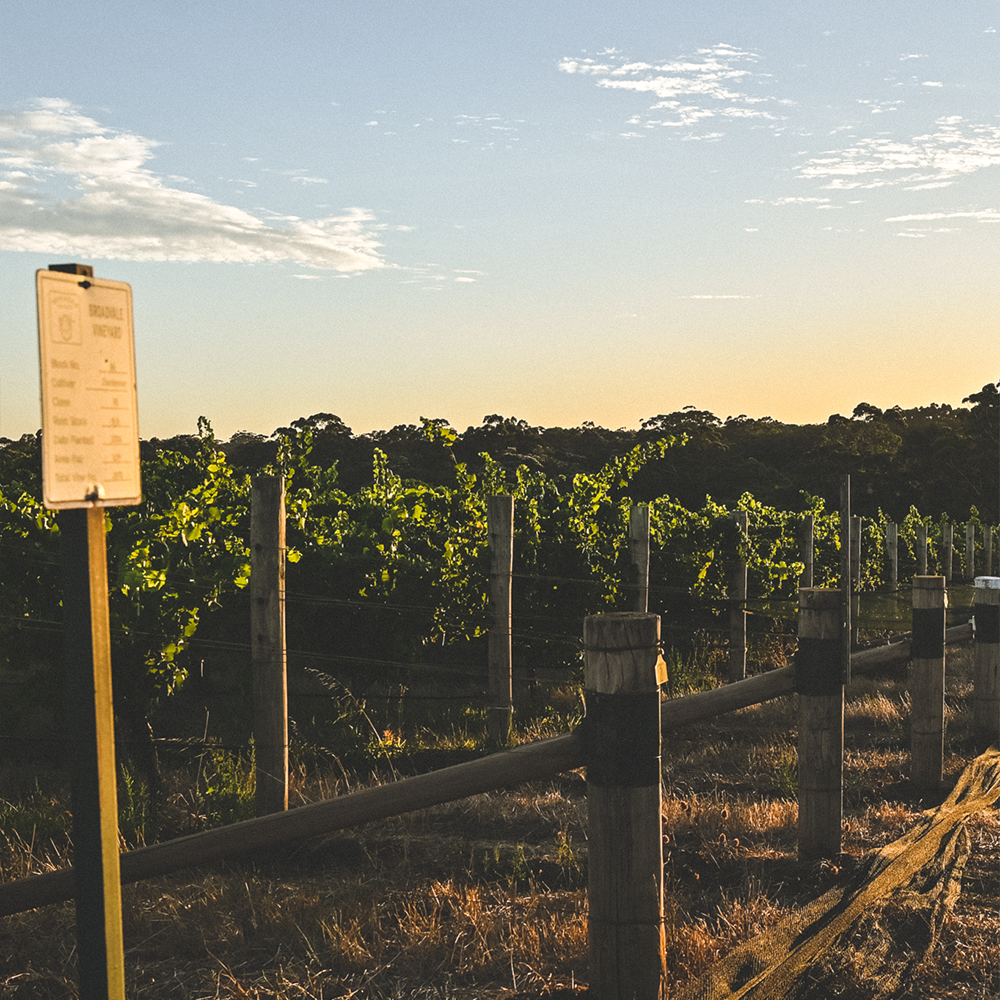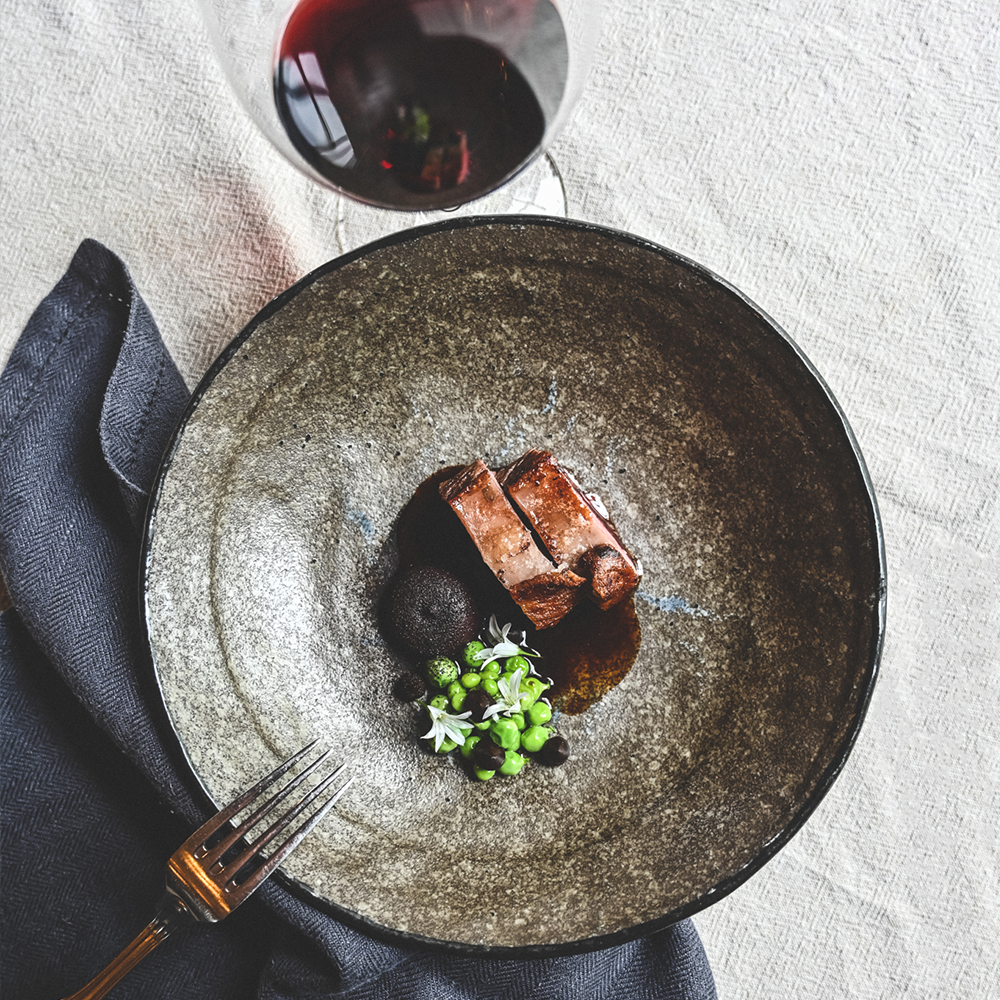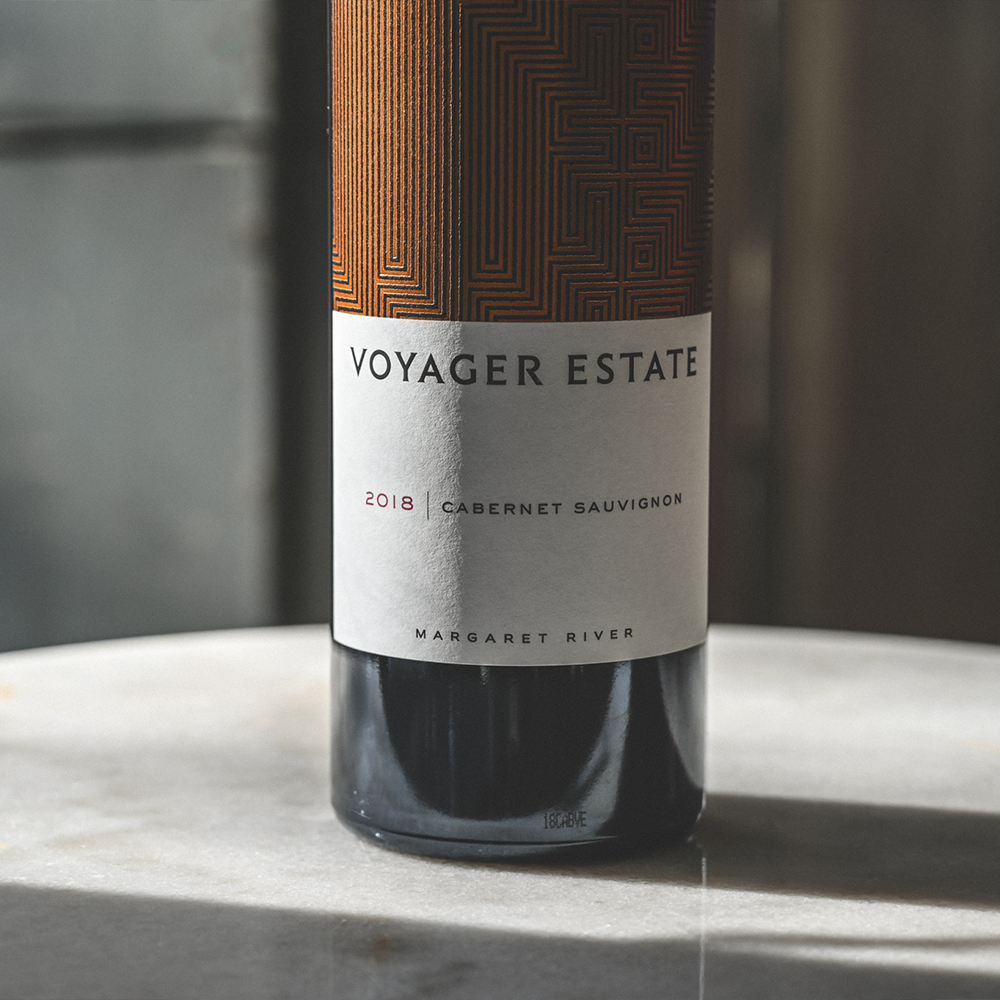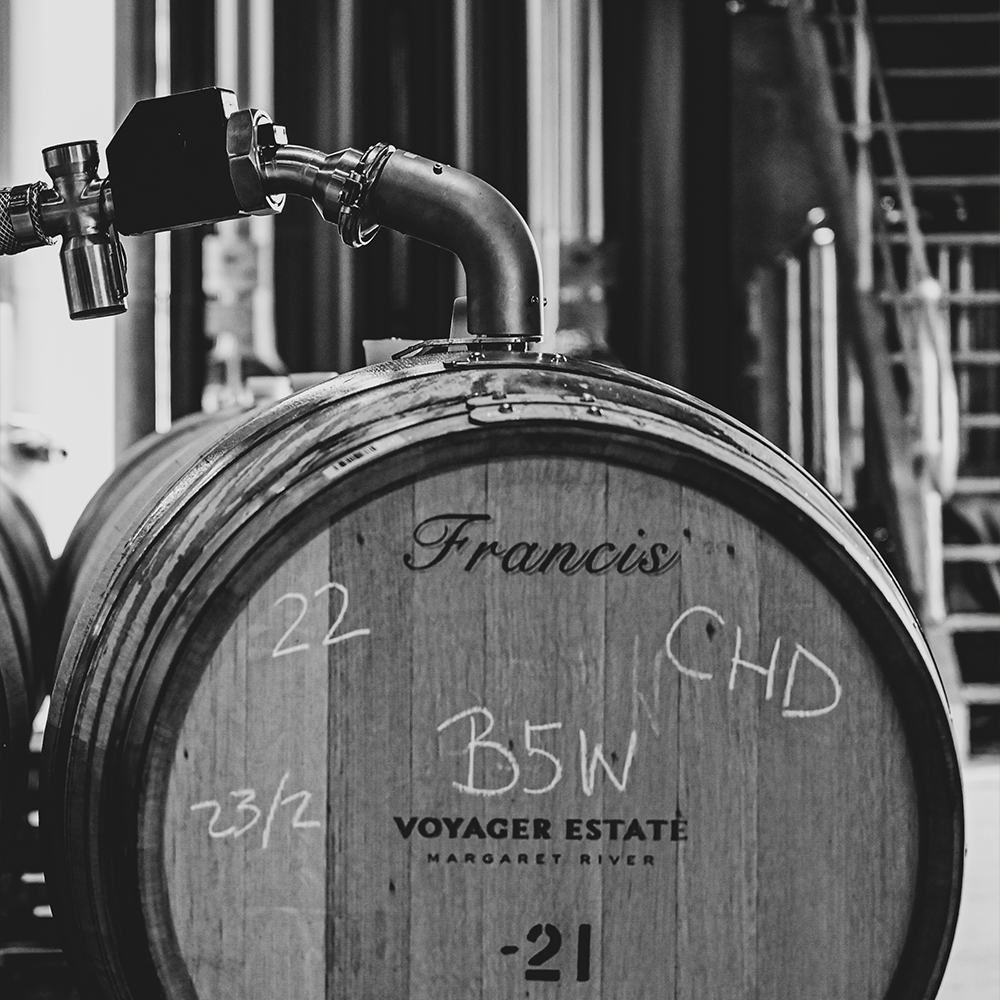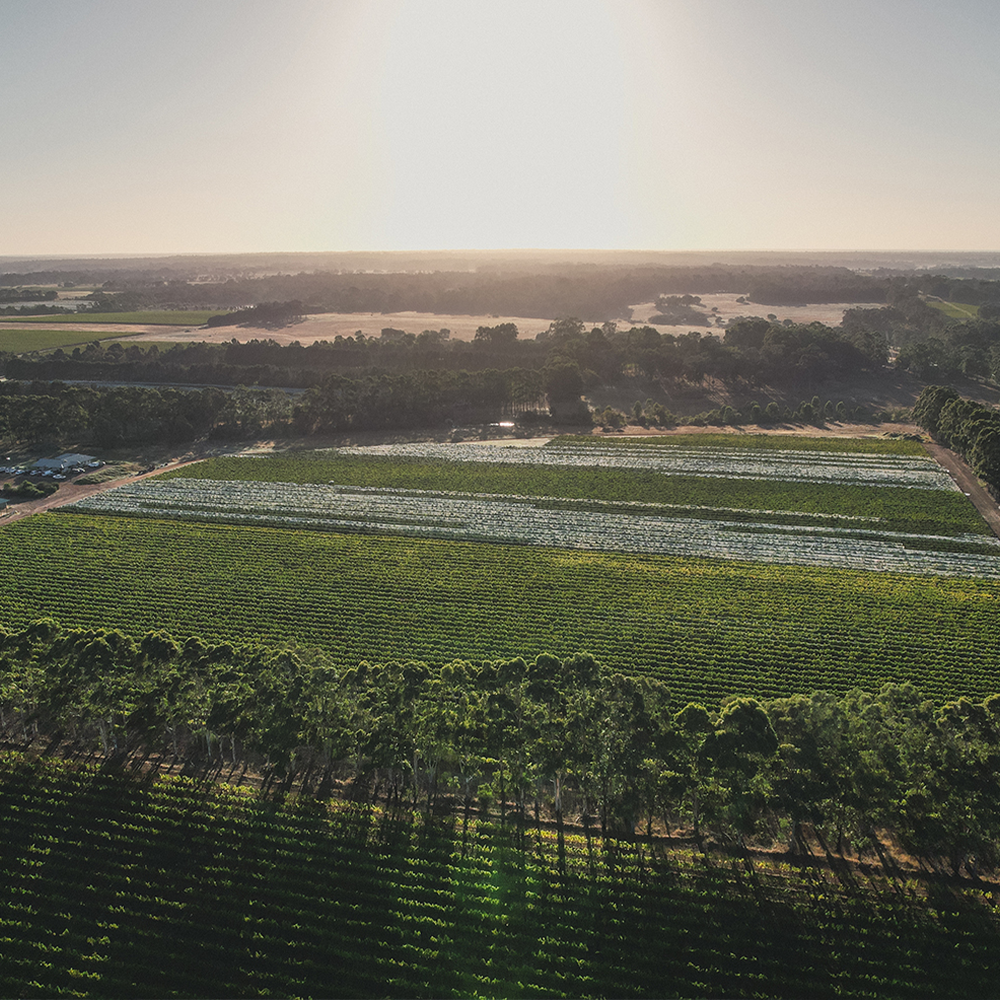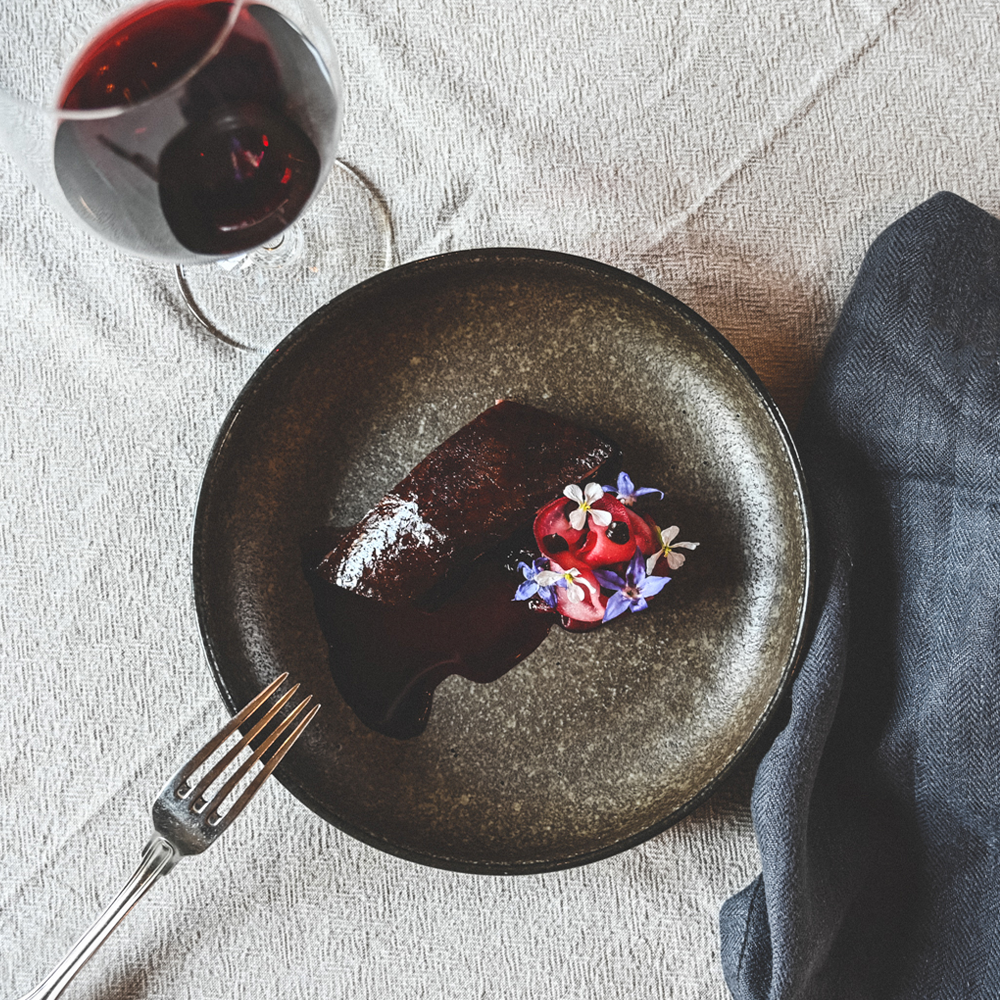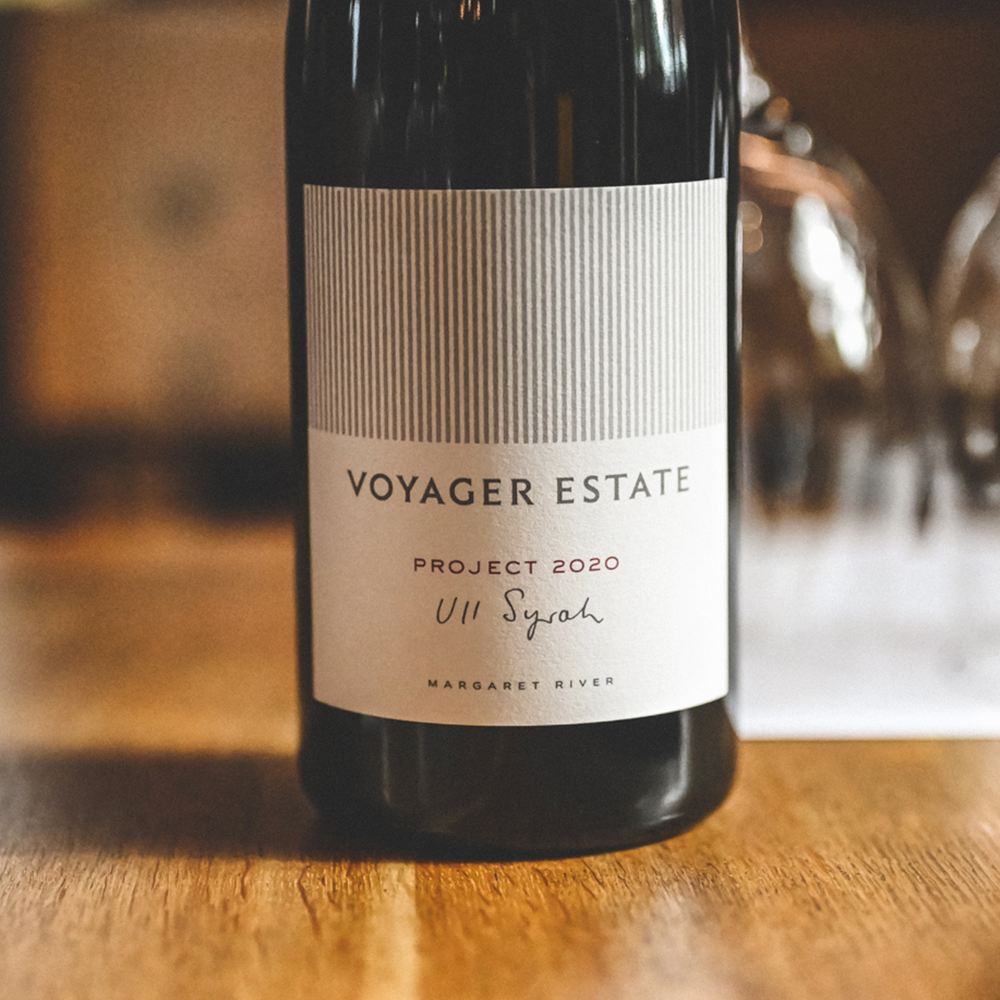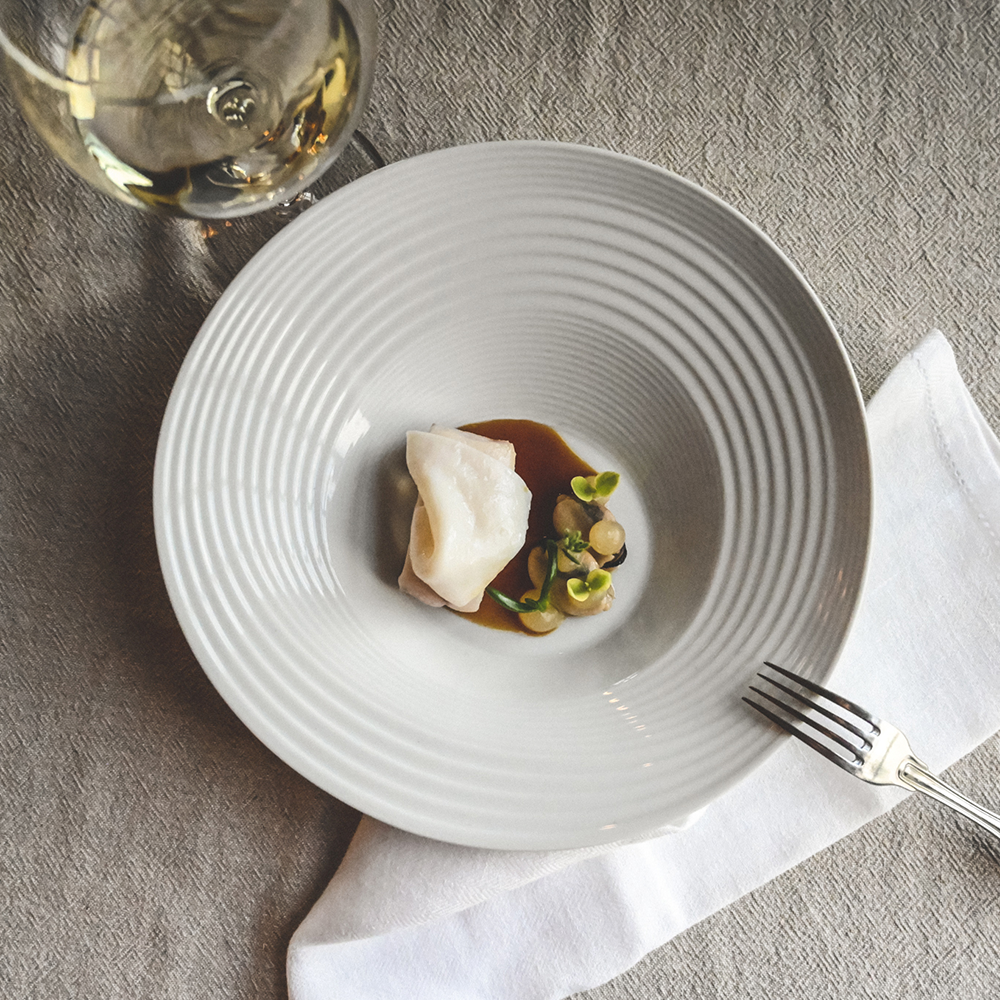Blog
A TRUE ORIGINAL
Our Market Development Manager and resident wine writer Tom Kline unearths the story of MJW – one steeped in legacy, terroir and a trusty pair of well-worn boots.
Beauty and dirt exist dichotomously in mainstream culture; the narrative is that the former looks down its nose at the latter with enmity and disgust. It’s an early and unavoidable indoctrination, engendered by fussing parents and ubiquitous advertising painting dirt as demonic and, well, dirty. And yet, as children, we’re endlessly drawn to it, allured to its potential for learning and making.
By all accounts, Michael Wright wasn’t one to conform to mainstream thinking, and when he looked down at the dirt surrounding his boot-clad feet in the pristine and undulating Stevens Valley, he saw eminent beauty and visceral promise.
Much has changed since those boots hit the ground in 1991, chief among them the replacement of herbicides, pesticides, and fungicides with blood, sweat and tears, ensuring a vineyard rich in living, organically-tended soil. It’s the purest expression of these soils and the Stevens Valley terroir that Voyager Estate strives to capture in a bottle. And at the very apex of that expression sit the MJW wines, Chardonnay and Cabernet Sauvignon, meriting the inscription of the founder’s initials. A homage to his vision.
Naturally, it was more than just the soil that caught Michael’s eye. A staunch advocate for data gathering and statistical analysis, he’d done his research and taken his myriad of notes and observations, fastidiously indexed and legible only to him and perhaps his tenacious assistant. Among the simplest observations was the repute of neighbouring producers, the potential for growth, and the idyllic location in which this dirt resided. He also wasn’t acting alone.
“I had to go under the fence to get the first soil samples before we owned the vineyard,” says Alexandra Burt, when recounting the early days with her father. “He said, ‘You’re smaller, you go get it’, and sent me trespassing with a jar,” she laughs. Statute of limitations aside, clandestine visits like these spoke to Michael’s broad curiosity, his unquenchable thirst for knowledge, and his abundant joy in its subsequent application.
Today, the MJW range is emblematic of these traits, of Michael’s quest for excellence. The range has seen vast evolution since its inception in 1992, the first vintage under Michael's stewardship. As was common to the time, ‘Reserve’ was its first moniker, before a change with the 1995 vintage to ‘Tom Price’ in honour of a man Michael very much admired. Not one for self-aggrandisement, Michael would never have allowed a label bearing his initials. However, some honours are too felicitous to ignore, and, two years after his passing, the 2014 flagship wines were labelled ‘MJW’. “I just asked for his forgiveness quietly on the side,” recalls Alexandra. “Even if he had disagreed, I would have gone into bat for it incredibly hard.”
It’s not just the name that has evolved, however. The wines themselves have morphed over time, not only aligning with the increased understanding of the vineyard, but also with the maturation of the range’s identity. “In the beginning, we felt that the wines needed more power to stand out above the rest of the range,” says Winemaker and Winery Manager Travis Lemm. “The first couple of vintages were richer and more opulent within the context of our style. The wines have since evolved dramatically, and now it’s about absolute purity, detail, structure, and finesse.”
2018 will go down in Margaret River’s history as one of the greatest Cabernet Sauvignon vintages on record, and with the 2018 MJW Cabernet Sauvignon recently hitting the shelves, the team at Voyager is buzzing with excitement. “2018 was so even and consistent across the blocks,” says Travis. “It was the perfect summer. We had amazing ripening conditions; it wasn’t too hot which suited Cabernet as it doesn’t mind some extra hang time. We also didn’t have any major rain events, and yields were moderate.”
The fruit for the 2018 MJW Cabernet Sauvignon came from two blocks. Old Block V9 is a legacy vineyard that was planted in 1978. Rooted in orange clay with heavy dark soil, it puts forward pretty, floral, and delicate Cabernet that expresses red fruit and violet notes. North Block U12 sits on a gravelly hill with a rocky ridge through its centre, allowing it to be more free draining. Its gravelly loam soils produce fruit in a more muscular spectrum, resulting in savoury characteristics such as dried herbs, briar, anise, chocolate, and blue fruits. The blend of these two sites has resulted in a wine of power and finesse, presence and grace.
The 2020 MJW Chardonnay was comprised of fruit from three blocks. Broadvale Block 6 is Voyager’s smallest vineyard at one hectare but holds immense importance in the Chardonnay program. Perched atop a gravelly hill, it slopes gently towards the east, capturing the morning sun with protection from westerly winds. The vines are rooted into granite and flinty chalky rocks, which contribute lean minerality and line.
The neighbouring Broadvale Block 5 has a large west-facing aspect exposed to the westerly winds and sunshine. Depending on the season, this vineyard can put forward wines of high acidity or intense fruit power. “We had pretty low yields on Chardonnay,” says Travis. “The 2020 vintage favoured the Block 5 site as the fruit had such great intensity.”
Voyager 12 sits on a sandier profile. It’s a low-yielding terraced vineyard that steps its way down into the Stevens Valley, receiving good air ventilation through the canopy, which helps to preserve acidity. The sum of these parts is a powerful Chardonnay with great fruit intensity and impact, supported by fine acidity and vineyard detail. Like so many visionaries, Michael Wright was enigmatic, engaging and highly singular. His prodigious imagination and irreverence towards conventional thinking forged the path that led to Voyager Estate.
Theodore Roosevelt once said, “Keep your eyes on the stars and your feet on the ground.” In true form, Michael kept his eyes on the ground and saw stars at his feet. “He didn’t see dirt as dirty,” recalls Alexandra. “He saw dirt as something functional and useful and something that you work with to create beautiful things.”
Beauty and dirt exist harmoniously at Voyager Estate, and they’re captured best in a bottle of MJW.
Q&A WITH TIM: PART ONE
Get to know our new Chief Winemaker in a two-part series of rapid fire questions, designed to delve a little deeper into Tim's background, passion and vision for Voyager Estate.
Complete the sentence. When you first laid eyes on our cellar door...
I had a lot more hair! It was 2004 and I was in my last year at Curtin University’s Margaret River campus. At the time I was impressed by Michael Wright’s clear ambition for the Estate. My (now) wife and I had one of our best Western Australian dining experiences in the restaurant. Would have been baked beans for a week after that.
What excites you most about joining Voyager as our Chief Winemaker?
I am excited to make wines grown from this ancient spot in Stevens Valley, from old vines managed by Glen Ryan, with decades of accumulated wisdom and the long-term commitment of Alexandra Burt and her family.
What makes the Stevens Valley so special?
Of all the wine-growing areas in Australia, there are just a handful of very special places that make wines that are not only distinctive but also world-class. The Stevens Valley is one such place, with all the known attributes of the wider Margaret River region but through a cooler and more detailed lens.
How do you like to begin the day?
My favourite way to begin the day is to be woken up on the wrong side of 6 am by my three children and our dog clambering over me until I have no choice but to get up and make them breakfast.
When you craft wine, what are you aiming to express?
The important role of patience and attention to detail, as well as the significance of beauty in human existence, even in very small doses.
What inspires you?
I am inspired by the people who drink the wines we make. None of this happens without them! It is a privilege when someone is willing to part with their hard-earned to ponder, appreciate and savour the nuances that go into wine.
The proudest moment in your career to date?
In 2015 at Punt Road, when I took my first wines all the way from grape to bottle. Having worked under some remarkable winemakers for over a decade, I led the winery team and made all the independent decisions on harvest, wine style and maturation. I got lucky with the year; 2015 may be the greatest Yarra vintage of all time! We won the trophy for best Shiraz at the Royal Melbourne Wine Show. Whilst trying not to get too carried away, it was a moment of joy and frankly, a great relief.
How does the terroir in the Yarra Valley differ from Margaret River?
Well for starters, the weather seems to hold a personal grudge against vignerons! Without the ocean’s moderating influence, nights are cold, and days can be very warm. The Wurundjeri People identify a fifth season from November to December – “Buath Gurru” in Woiwurrung. It’s an unpredictable time between spring and summer with high winds and hailstorms, which coincides with fruit set. The gap between greatness and catastrophe is always a small one.
Favourite wine region outside Australia?
Predictably, Burgundy! The distinct villages each have their intricate hierarchy of terroir. I also love the humility and generosity of its makers.
What do you love most about Chardonnay as a variety?
It asks questions of the maker, such as the right oak selection and the length of maturation required in barrel and bottle.
What do you love most about Cabernet Sauvignon?
...because of its honesty. Pinot Noir on the other hand is a deceptive minx! If you plant Cabernet in the right spot and make thoughtful decisions in the vineyard and winery, then it inevitably becomes a complex wine with the potential to age for many years.
Stay tuned for part two in the coming weeks...
ROCK STAR
Broadvale Block 6 has always held a special place in our hearts. This small east-facing block has an intriguing back story – one steeped in exploration, evolution, and an explosion to boot – that saw it emerge as one of the most exciting parcels of Chardonnay on our Estate and a cult favourite among the team.
It all began with a seemingly humble discovery. A small area on the western side of the property littered with stony, gravelly soils and large chunks of quartz, capturing the morning sun with protection from westerly winds. To most it would’ve looked insignificant, but the team recognised the potential in the dirt almost immediately. A small block on totally uniform and exceptional soils – the perfect spot to plant the French clone, Dijon 95.
The decision was made in 2004 to move ahead with planting the site – an exercise that proved challenging at first. Hiding below the soil were large granite boulders, preventing us from installing the necessary trellissing to grow the vines. Eventually, after much trouble shooting, the team resorted to loosening the granite with explosives!
In those initial years, the vines really struggled as they took up root in the soils. The first two crops yielded nothing exciting. However, with a bit of perseverance, the vines developed leaf cover and strength and the team knew they had something special. As our organic farming methods evolved and brought more biodiversity to the site, the vineyard started to thrive, and the Chardonnay developed more elegance and purity.
Over time our team have discovered that, as a juice, Broadvale Block 6 fruit ferments naturally due to the lower sugar levels at harvest. The flavour profile builds nicely during ripening and is quite distinctive – think aromatic white flowers, gentle lemon, grapefruit, and lime. The vines, rooted in granite and flinty chalky rocks, contribute a saline minerality and water cracker texture which has been likened to the wines of Corton from the iconic region of Burgundy.
Our team works with specific oak coopers, forest origins oak and just the right toast level to accentuate these unique characters. The sum of all parts is an atypical expression of Margaret River Chardonnay with a savoury, fine-boned structure, and a fantastic energy; a single-site wine that reveals a unique snapshot of site and season and represents both a spirit of determination and our passion for crafting true expressions of place.
Over the years, it has also reinforced the need for us to stand back and let the fruit do the talking. The block’s inherent elegance, coupled with Margaret River’s signature underlying power, has always required a lighter touch and our team have been careful not to get too ‘fancy’ with technique. It’s a guiding philosophy that has inspired and informed our journey to organic certification and is now front of mind when crafting all our wines.
The 2021 vintage brought a mixed bag of weather across the region. In Stevens Valley, we had good early season growth followed by some November rain and hot, dry early summer conditions. February brought some extra rain. Our organic farming had the vineyard in terrific shape to deal with any challenges, and Broadvale Block 6 was harvested with lovely fruit purity and an exciting acid drive – another release that the team are exceptionally proud of and thrilled to share.
Voyager Sommelier, Claire Tonon says of this year’s release, “2021 provided a wonderful growing season for our Broadvale Block 6, the cooler ripening conditions helping to really showcase the Dijon clone’s pristine, yet delicate, lime and white flower prettiness. Combined with malo-derived creamy texture and a light butterscotch note, beautifully balanced oak and tight natural acidity, this wine has it all! I would suggest decanting for best drinking in its younger years and for those with patience, this wine will truly blossom with the integration of six to eight years’ bottle age.”
To add the very limited Broadvale Block 6 Chardonnay to your collection, sign up to The Fold.
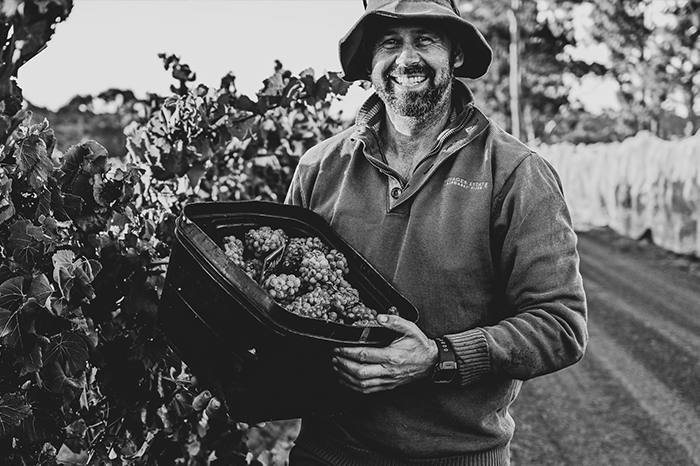
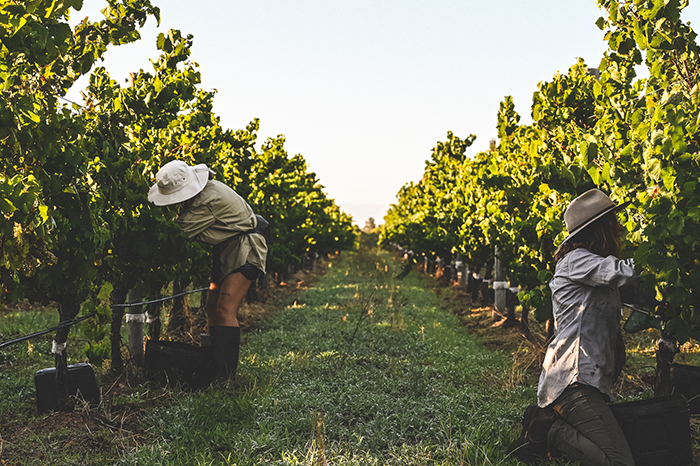
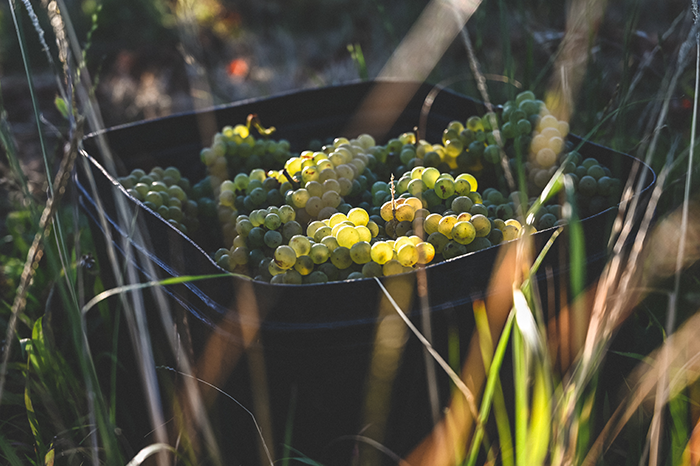
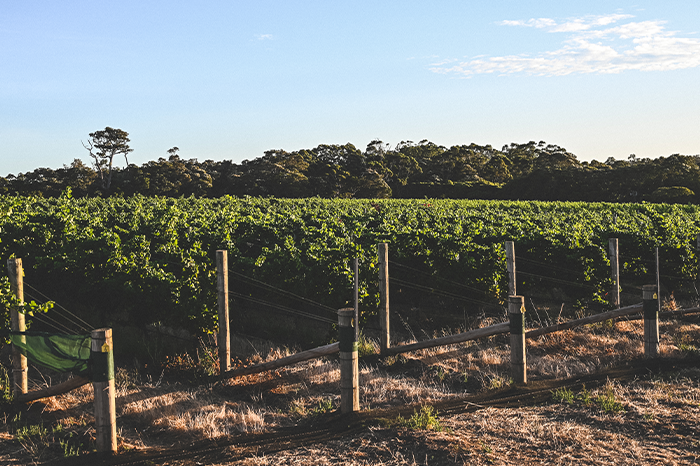
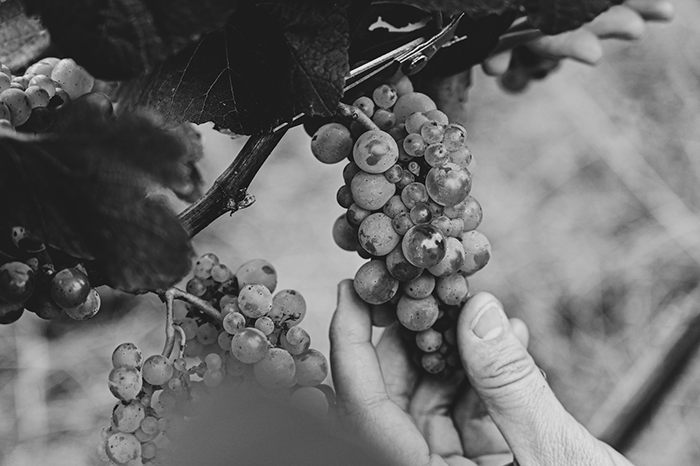
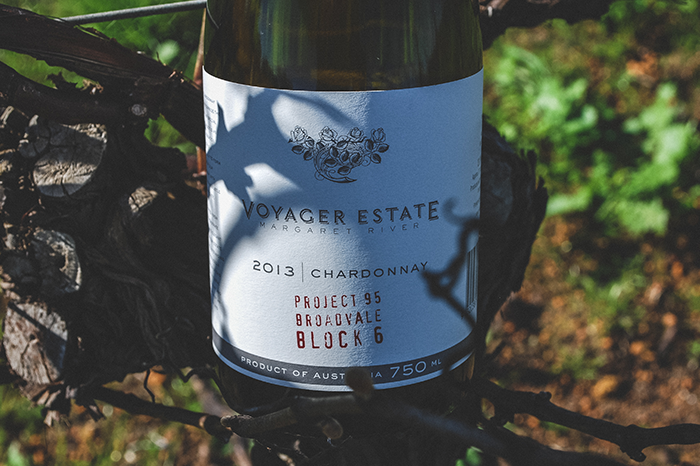
FLORIS
The arrival of spring signals bud break, vigorous growth, and flowering – the vineyard breathes and bursts with new life. Buds form into leaves and tendrils, then finally, the first tiny flowers start to appear on the vines.
Bees, lacewings, spiders, and ladybirds move quietly through the foliage, enriching our land’s precious biodiversity. Colourful cover crops begin to bloom, competing for water and balancing soil moisture following the region’s heavy winter rains. Eventually they decay and the lifecycle feeds nutrients back into the ground.
This time of youthful abundance inspires our new seasonal menu, FLORIS [Latin: flower], featuring our take on a succulent spring classic – Jindong lamb back strap, peas, and carrots.
The lamb back strap is sous-vide with a combination of peppercorns, bay leaf and thyme, seared fat side down until caramelised, then placed in the oven, basted with butter, and finished on the hibachi grill. A silky purée is created from purple carrots, which have been sous-vide with butter and miso and then blended with beetroot, lemon, and locust bean.
The lamb is served on top of the purée, alongside locally sourced spring peas and broad beans compressed with pepper berry oil, and a black garlic gel. The dish is garnished with a lamb jus that has been caramelised and infused over eight hours.
Chef Ray Van Puymbroeck and Sommelier Claire Tonon have chosen to pair this spring dish to our flight of three Cabernets, creating a complex flavour journey.
“Umami character abounds, pulling these three wines into line and accentuating their structure. This is balanced by the light acidity of the black garlic gel and powder, which emphasises the pristine fruit. Herb and spice notes echo and balance those same characters in the wine. There’s also a toasted character to the dish that helps to bring through any subtle oak.
My recommendation – taste the lamb and jus alone with the 2020 Girt by Sea, then add the garlic and greens with the 2020 Modern, and take a whole mouthful of everything to match the structure and intensity of the 2018 Cabernet!” says Claire.
Immerse yourself in the flavours of spring – book your FLORIS degustation experience here.
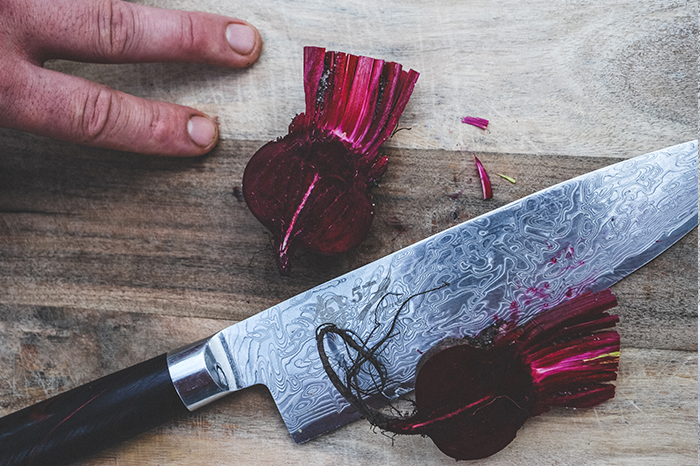
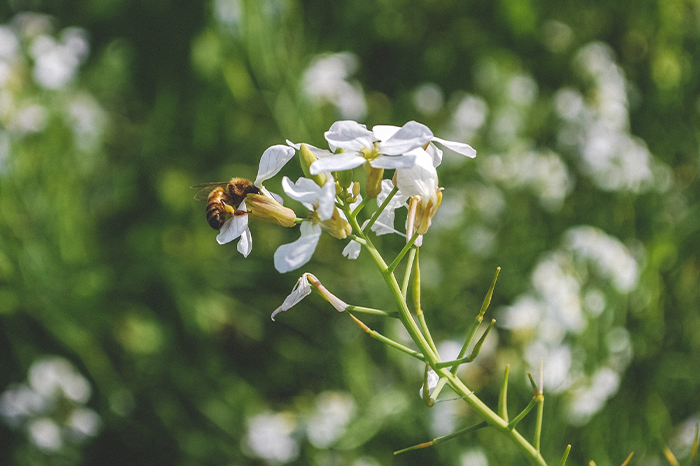
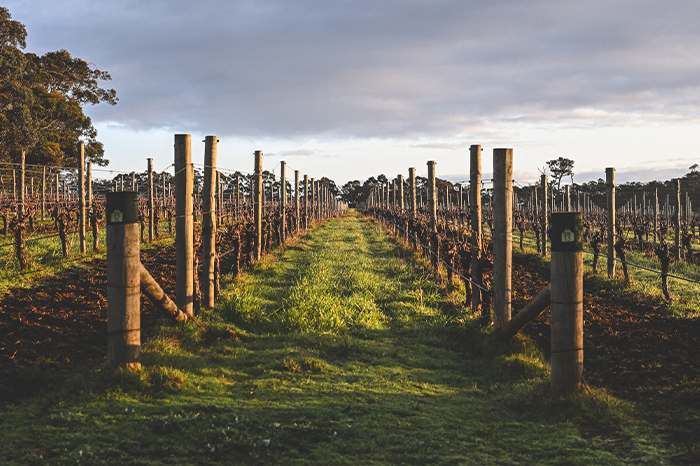
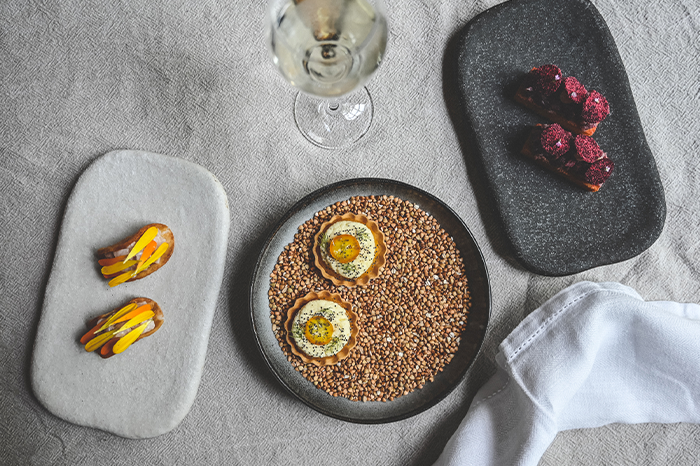
THE GOLDEN YEAR
The 2018 vintage had the region abuzz with excitement and is widely touted as being one of our best seasons on record. Winemaker and Winery Manager, Travis Lemm, dives a little deeper into how the stars aligned to produce some of Margaret River's most exceptional Cabernet.
“You will not find many producers in Margaret River that don’t consider the 2018 vintage extraordinary!
We had early budburst across the region and a warm November, before experiencing some wet conditions in December that bolstered soil moisture. From there, the season progressed steadily, enabling quite slow ripening across varieties. Highly advantageous, as the fruit flavours accumulate nicely without an acceleration in overall sugar levels, which leads to perfect balance!
Through March and early April, we had amazingly sunny days and cool nights, which held the acidity in the grapes, concentrated flavours, and developed perfect tannins in our Cabernet Sauvignon.
There was no rush to harvest. We tasted early tannin ripeness in the fruit and then had the luxury to wait until we considered the flavour concentrations to be at their peak before picking. In the winery, all the ferments behaved as the fruit was in stunning condition. We progressed to some extended skin contact on a couple of parcels from North Block, which allowed more extraction of soft powdery tannins in the wines.
This was the type of season where we looked at the wines and knew they were going to be special. For me, if the balance of fruit concentration and tannin is there at six months of age in barrel, the wine is going to be exceptionally strong.
Blending our 2018 Voyager Estate Cabernet Sauvignon and 2018 MJW Cabernet Sauvignon was an easy process. Old Block, North Block and their relevant parcels had the perfect fruit structure and tannin depth.
The MJW Cabernet is crafted to retain delicacy and purity, so the 2018 release is more dominant in Old Block which has a rich fruit profile. By comparison, our Voyager Estate Cabernet is our legacy in a glass, possessing tannin definition supported by classic cassis, so it holds more North Block fruit at its core.
Overall, it was a fantastic season, and the results are in the glass! Both these Cabernets express elegance, power and stunning fruit character, reflective of a truly standout year in the history of Margaret River."
OAK & VINE
Throughout history, the oak barrel was mostly used for practical purposes, transporting wine from one place to another. Somewhere along the journey, a discovery was made – the barrels were imparting flavours and characters into the liquid gold sloshing around inside. Fast forward to today and we have modern winemaking, with oak barrel selection an often critical component of the craft.
At Voyager Estate, we maintain a select core team of sustainably farmed oak suppliers and barrel coopers who we work with regularly, but we are always experimenting with the different variables – forest selection of oak, stave seasoning and barrel toasting profiles – to ensure a constantly evolving program.
Winemaker and Winery Manager, Travis Lemm, is incredibly passionate about curating the right oak profile for each of our wines. “Oak, like wine, is sourced from specific land with its own unique micro-climate, weather variation, and soil – meaning it is an expression of place that can impart different characters. We work with a complex combination of oak and toasting levels to impart just the right amount of influence, without overpowering our pristine fruit."
There is no better example of where this process comes into play than with our prized Chardonnay blocks. The team works to match the oak to the different Chardonnay clones grown on the Estate, each with their own unique characteristics, to craft our expressive cuvees.
“The classic Margaret River Gin Gin clone always has powerful fruit, tight acidity, and great length, so we select oak that is seasoned and toasted to support these attributes – for example, we like to accentuate that length and keep those pristine fruit flavours at the front of the palate. The barrel also provides mid-palate richness," says Travis. “Clone 95 is a different prospect. It can be a little more subtle and citrus-toned, and, as we often utilise malolactic fermentation to soften the natural acidity, we are looking for oak that provides length and richness, rather than upfront oak flavour that may dominate the delicacy of the wine.”
Cabernet also has an array of fruit characters and tannin profiles that should be supported, not dominated, by oak. Different Cabernet expressions often require a variation in choice of oak, from the grain size of the timber, to stave thickness and toast levels.
This complex process of ‘match-making’ often involves working directly with coopers to develop barrels to suit the specific blocks. Coopers are masters of their craft and know how to achieve a particular style from their own oak selections when making barrels. This allows consistency of expression from year to year, which is an important factor for winemakers, as it helps mitigate the differences in wine style that can come from seasonal climate variance.
“We develop close working relationships with our coopers over time, to refine the style of oak used as our vineyards age and the subtleties of the season add to our knowledge base," Travis continues. “Wines may be matured in barrel for a few months or even years, so the choice of oak is critical. As organically certified growers and makers of wine, we do not add fining agents, thus we only work with high quality materials. We cannot have any 'sharp' edges or rough tannin profiles imparted to the wine, that may take away from its sense of place.”
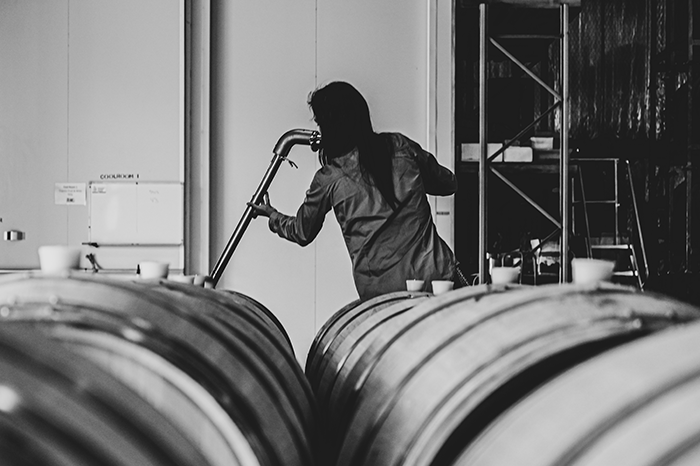
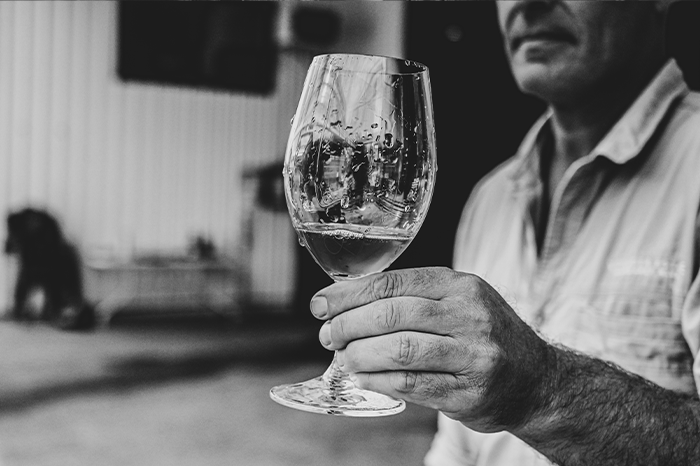
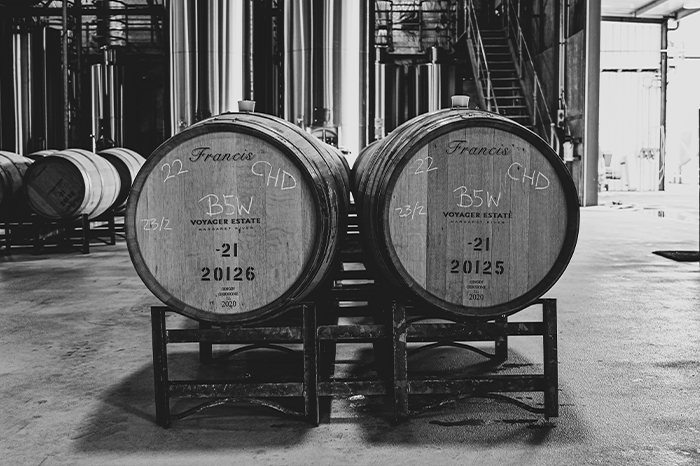
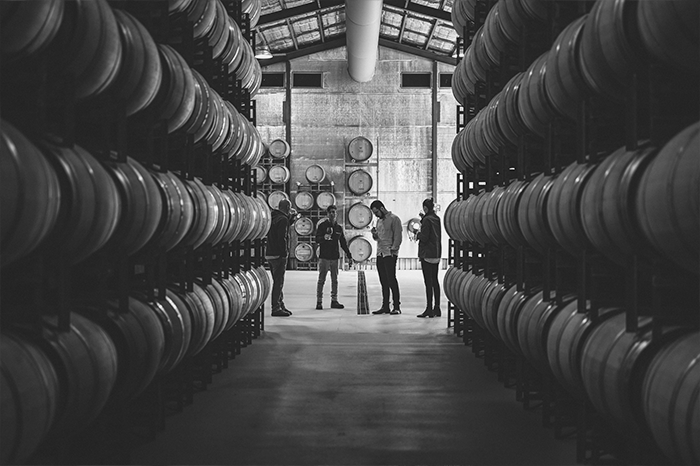
PROTECTING BOODJIDUP BROOK
It’s been over 15 years since Voyager Estate first recognised the need to protect and improve the health of the Boodjidup Brook catchment area.
The Boodjidup Brook and its tributaries run right through our Estate, entering and exiting at multiple locations. Maintenance of the riparian zones (the area where the water meets the land) is vital to prevent erosion, increase biodiversity, and ensure water quality.
An action plan released by the Cape to Cape Catchments Group back in 2009 provided various recommendations on how we could enhance and restore the existing natural environment, including building fences, weed management, installation of vegetation ‘buffers’ using local species, and controlling erosion.
The team took these recommendations and got to work! Each riparian zone was mapped out with its own unique staged action plan, depending on the level of degradation and restoration that was needed. They prepared the site for planting by ripping and mounding the soil and removing weeds where necessary (nightshade, thistle, reeds, and bridal creeper just to name a few).
As the business evolved on the pathway to organic certification, in a bid to outcompete weeds without herbicide use, they also increased our tree planting density. Based on suitability to soil type and moisture content, native species were carefully selected including marri, wattle, banksia, blackbutt and kangaroo paw. Fencing was installed to keep grazing livestock from eating the precious new seedlings. The team further combatted erosion with the placement of rocks in the water channels. This created ‘rock pitches’ to slow water flow through these areas, stabilise banks and allow new plants to establish.
Previously, Weightmans Dam was an eroded and overgrazed sheep paddock. Dry and dusty in summer and boggy pools of water in winter. When the dam build was completed in 2017, more than 20,000 native species were planted around it, creating an aquatic habitat, controlling water flow, and stabilising the natural environment.
Since commencing the revegetation project all those years ago, more than 60,000 native species have been planted across our property – an amazing achievement. We now monitor and maintain the rehabilitated areas through ongoing livestock exclusion and weed management. Planting in higher densities at the start, combined with a ‘light-no-touch’ approach, has resulted in significant natural ecological regeneration.
In addition to these efforts, the team have also been testing the waterways throughout the property since 2007. Samples have been taken quarterly at Weightmans Dam, providing insights into the impact our farming practices have on water quality and how our rehabilitation efforts are mitigating these impacts. Creating an ecological wetland system is nature’s defence against water pollutants.
We are seeing promising results, in both the decrease in nitrate levels and an increase in biodiversity. Weightmans Dam has seen a marked increase in critters like birds and frogs. With time, the team are hoping to be able to class this area as ‘native species dominant’.
The rehabilitation of the Boodjidup Brook area is a complex and ongoing effort, and is nicely summarised by Voyager's Technical Viticulturist, Alex Miller.
"The sum of all parts has created a patchwork of native vegetation corridors through Voyager Estate, with significant increases in biodiversity, stabilising watercourses and natural habitats for a diverse range of beneficial flora and fauna," she says.
MJW CABERNET & ROAST DUCK RECIPE
The 2018 MJW Cabernet Sauvignon is silky, structured, and stunningly complex – the ultimate expression of our Stevens Valley soils. Chef Ray Van Puymbroeck and Sommelier Claire Tonon have weaved their culinary magic to create the ultimate flavour pairing, perfect for your next dinner party.
The umami-rich duck and accompanying jus highlight the fine tannins and acidity, while the pickled plum and garlic provides balance, returning the wine’s complex array of berry tones. The spice notes in the sauce and the charriness of the plums also echo the spice and charred notes in the wine, imparted from exceptional French oak.
Accompaniments can be prepared ahead of time, so all that is needed on the day is to heat, assemble and enjoy...
INGREDIENTS
AGED ROAST DUCK
- A whole medium-sized duck (1.8 – 2kg)
- 1 tbsp apple cider vinegar
- 1 tbsp soy sauce
- 1 tbsp honey
DUCK & PEPPER JUS
- 2 kg duck necks, bones and trimmings
- 1 kg chicken wings
- 2 onions
- 2 carrots
- 2 sticks of celery
- 6 garlic cloves
- 2 bay leaves
- 8 all spice seeds
- 10 Szechuan peppers
- 100g coriander root
- 8g ginger
- 100g dark soy sauce
- 3 litres water
PICKLED & CHARGRILLED BLOOD PLUM
- 2 blood plums, sliced in half, stone removed
- 150 ml apple cider vinegar
- 50 ml water
- 50g sugar
- 10 black peppercorns
- 2 bay leaves
- 1 tablespoon olive oil
BLACK GARLIC PURÉE
- 200g garlic noir
- 50 ml water
- 50 ml grapeseed oil
- 3g salt
METHOD
10 DAYS PRIOR
- Blanch whole duck in boiling water for 15 seconds to sterilise and place on metal rack
- Mix vinegar, soy sauce and honey together and brush over the duck
- Leave duck uncovered in fridge, brushing with the vinegar and honey mixture once a day
2 DAYS PRIOR
- To prepare duck and pepper jus, soak the duck bones, meat, and chicken wings in a bowl for one hour, changing the water four times
- Dice vegetables, then add to a large pot with all other ingredients. Allow to simmer on low heat for four hours with lid off
- Strain through a paper filter (coffee filter or muslin cloth) and refrigerate
- To make plums, add all ingredients (except plum halves) to a saucepan and bring to the boil, then remove from heat and allow to cool
- Pour mixture over the plum halves and keep in an airtight container in the fridge
- Prepare the garlic purée by blending garlic and water in a food processor to make a smooth paste
- Slowly add oil to the food processor to emulsify purée, season with salt and refrigerate
ON THE DAY
- Preheat oven to 190 degrees, remove duck from fridge and bring up to room temperature for 20 minutes. Place duck in oven to cook for a further 20 minutes.
- Whilst the duck is cooking, remove garlic purée from fridge and bring up to room temperature
- Prepare plums by straining, brushing with olive oil and chargrilling on a hot griddle pan. Remove from heat.
- Heat the duck and pepper jus slowly in a saucepan
- Remove cooked duck from oven and rest for 10 minutes
- Carve each duck breast lengthways to make four pieces. Add one duck breast onto each plate, skin up, and place a half plum next to it. Sprinkle with sea salt.
- Use a teaspoon or sac-a-poche to add small dots of purée around the plate
- Spoon the jus around the duck and garnish with edible flowers if desired
Recipe serves four.
RISING STAR
You’ve probably heard the old adage, ‘Cabernet is king’ and globally, this definitely rings true. Cabernet is the most widely planted grape variety in the world, crafting some of our most revered and long-lived red wines.
In Australia however, the story is a little different. Shiraz is our key red grape variety, and we’re home to the world’s oldest Shiraz vines believed to date back to 1843! This is largely due to the wine boom of the '80s and '90s, which saw it planted in nearly every wine region across the nation. Initially, the Shiraz that emerged was rich, structured, oak-driven, and packing a flavour punch – a wildly popular style, and one that Australia would become famous for.
In Margaret River, this thirst for big, bold Shiraz threw winemakers a bit of a curve ball. Situated in a climate with cooling coastal sea breezes, we struggled to achieve the dominant ripe fruit characters that fans had come to expect when they picked up a bottle of ‘Australian Shiraz’.
Thankfully, as our so called ‘classic style’ continued to grow impossibly big through the early 2000s, a quiet revolution began; one that favoured a lighter touch in the vineyard and winery to allow the elegance and perfume of the variety to shine through. This new expression bore more resemblance to the French style of Shiraz known as ‘Syrah’ – a wine that was more medium-bodied and savoury, produced in a much cooler climate.
It was about this time, when conversations about the potential of Syrah in Margaret River were just beginning, that the Voyager team identified a section of our U11 vineyard that was special.
“This particular section had the perfect aspect with that slight north face. At the top of the ridge, the soils were harder, bonier and a bit more gravelly and free-draining” recalls Winemaker James Penton.
“We wanted to pick it as an individual section, so we did complete hands-on viticulture – reducing fruit loads to only one bunch per shoot to increase flavour intensity and removal of lateral shoot growth to increase airflow and sun exposure. Different to the rest of the block, purely because we wanted to see just how good a quality of fruit we could produce.”
The Project U11 Syrah was born. Today, the spirit of innovation continues as we launch our certified organic 2020 vintage – fresh, bright, silky and bursting with red berries, mocha and sage. A culmination of many years of gentle exploration, reducing oak influence and experimenting with concrete. It grows more exciting with every release.
Over the years, our Cellar Supervisor Richard Bramston has played a driving role in the creation of our Syrah and its evolution. “We’re loving what concrete does with the wine to really finish it off and round out any rough edges. The 2020 had three months’ maturation in concrete at the end. It did an amazing job and it’s definitely a go-to now! I love that Shiraz is like the Chardonnay of reds – it allows us to play with technique. That’s the exciting part of working with it” he says.
There’s no doubt that Syrah is very much at home here in Australia, with so many delicious and nuanced expressions hitting the shelves. At Voyager, the team will be looking to evolve our version to let the fruit do even more of the talking.
“We’ll identify new techniques in the winery that allow us to work more with stalks to fine-tune those beautiful aromatics and build better tannins in the berries, rather than acquiring them from oak” continues James. “The more work we do in the vineyard, the better and more expressive our wines will be.”
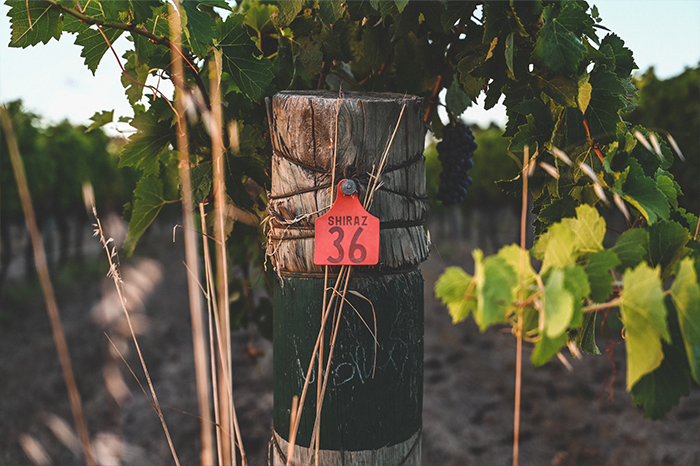
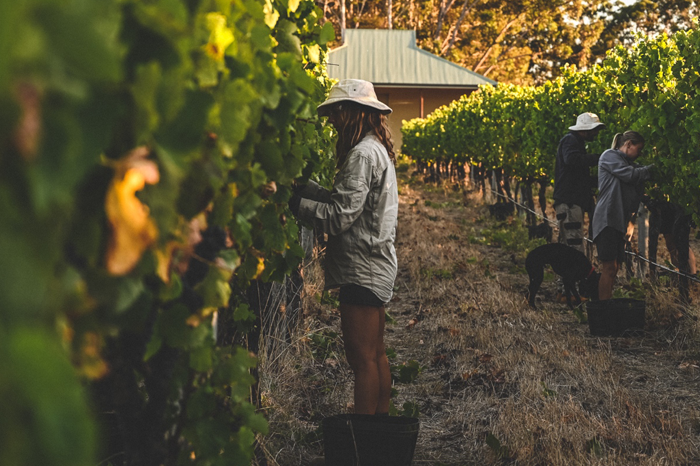
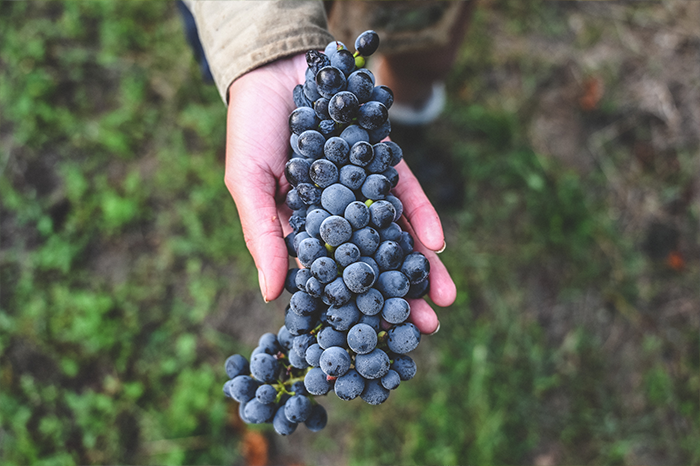
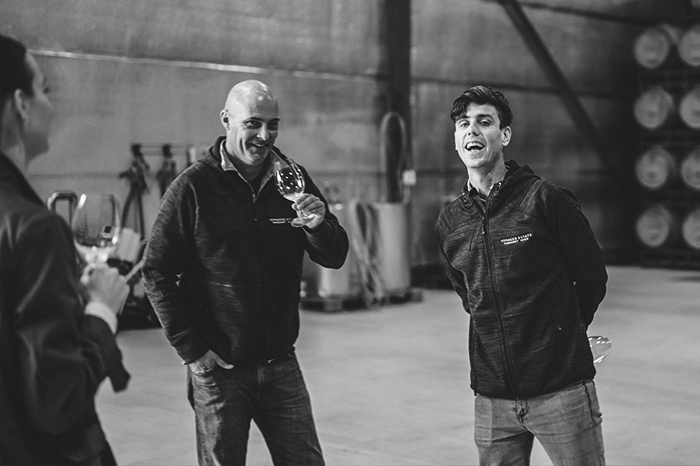
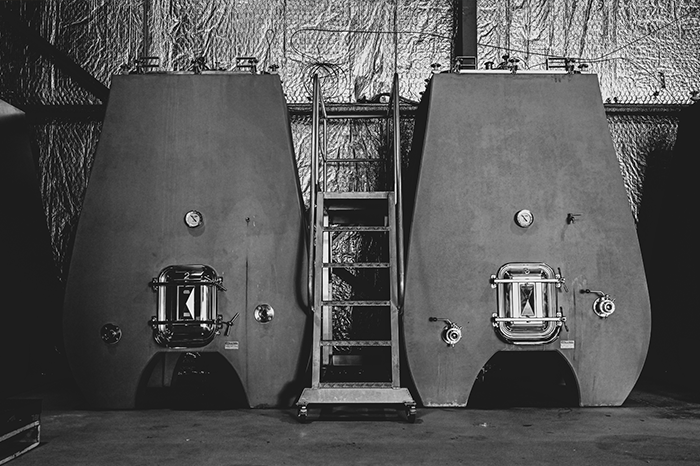
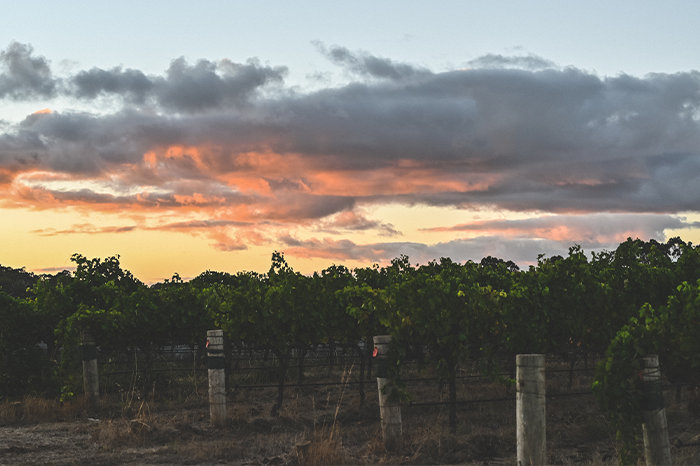
SOLI
As we pass the winter solstice and seasonal showers roll across our region, the vineyard begins its slow process of regeneration. The vines lay dormant, and we embrace the crisp vitality of winter – colder days, punctuated with storm fronts that whip in from the ocean. This is the most important season for building fertile soil – the vineyard’s lifeblood.
Our Vineyard Team select the best canes and gently lay them down, pruning foliage as they go. In turn, cuttings are mulched and returned to the earth as organic matter, enriching the vineyard floor.
It’s a sustainable, interconnected cycle that ensures nothing is wasted, and one that inspires our SOLI [Latin: soil] menu from the ground up – heroing our organically farmed wines of place alongside the pristine produce gifted by our region’s ancient soils.
Featured on this menu is our Line-caught Fish, Scallop and Mussels – inspired by the roaring winter oceans that supply us with an abundance of fresh seafood at this time of year.
Line-caught fish, sourced from Busselton, is lightly salted and gently poached or steamed. Locally sourced mussels are cooked with peppercorn and kaffir lime, and then smoked. This pristine coastal produce is served alongside a chicken and lime sauce, scallop silk and a Chardonnay yuzu gel. The dish is finished with an array of coastal plants, including pickled Karkalla from the Voyager Garden.
This stunning dish is paired alongside our certified organic single vineyard Chardonnay, Broadvale Block 6. The wine displays delicate floral and flinty notes, with intense citrus and a lovely mouth-coating texture – perfectly amplified by the ‘savours’ of yuzu, kaffir lime and our pickled Karkalla.
The chicken and lime sauce is deliciously umami and the line-caught fish and mussels, with their mineral notes and varying amounts of sweetness, serve to highlight the more structured side of the Chardonnay. The smoked mussel also brings through some of the wine’s lovely oak character.
Immerse yourself in the season of SOLI with a degustation experience this winter...
